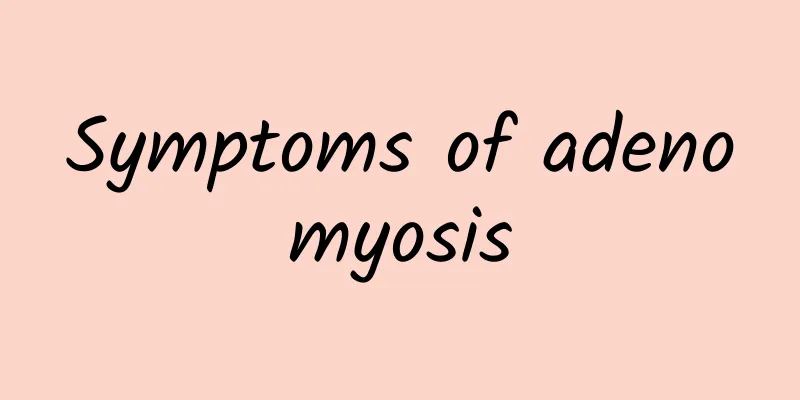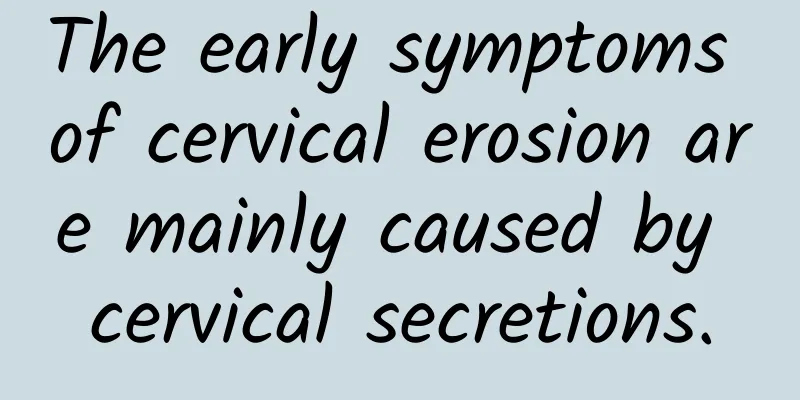Symptoms of adenomyosis

|
The main symptoms of adenomyosis include heavy menstrual flow, severe menstrual pain, irregular bleeding, and possible fertility difficulties. For the above symptoms, you should seek medical attention and treatment as soon as possible to prevent the disease from progressing. The following is a detailed analysis of possible symptoms and how to deal with them. 1 Severe menstrual pain: The menstrual pain of adenomyosis may be significantly aggravated. Unlike ordinary dysmenorrhea, this pain is often persistent and may start a few days before menstruation and last throughout the menstrual period. It may even still hurt after the menstrual period ends. This is mainly because the endometrial tissue invades the myometrium, causing local inflammation and enlargement of the uterus. For this symptom, you can choose non-steroidal anti-inflammatory drugs such as ibuprofen to relieve pain, or use hormonal drugs such as levonorgestrel intrauterine contraceptive system or goserelin to relieve symptoms under the doctor's advice. Severe cases may need to consider surgical treatment, such as hysterectomy or lesion resection. 2. Excessive menstrual flow: Patients with adenomyosis often experience excessive menstrual flow, which may even lead to secondary anemia. This is because the myometrium is affected by the invasion of the endometrium, which reduces its elasticity and makes it difficult to effectively contract and stop bleeding. For heavy menstrual flow, conservative treatments such as oral contraceptives and placement of a levonorgestrel intrauterine contraceptive system can be used to adjust hormone levels and reduce menstrual blood flow. If necessary, uterine artery embolization can be performed to reduce blood supply to the uterus, thereby alleviating symptoms. 3. Irregular vaginal bleeding: Some patients also have irregular vaginal bleeding during the non-menstrual period, which is caused by abnormalities in the uterine wall caused by adenomyosis, resulting in increased bleeding. During treatment, the cause of bleeding should be confirmed by B-ultrasound or magnetic resonance imaging to exclude other diseases. In terms of treatment strategy, drug regulation can choose hormone therapy such as GnRH agonists to control the disease, and surgical treatment can be used for severe symptoms. 4Fertility-related issues: Adenomyosis may affect fertility because the lesion causes an abnormal intrauterine environment, hindering embryo implantation or increasing the risk of miscarriage. For women who want to have children, treatment often focuses on preserving uterine function. Medical management is usually the first choice to control the disease, and then assisted reproductive technology, such as IVF, is selected according to personal needs and health conditions. The characteristic symptoms of adenomyosis are prominent and may significantly affect the quality of life. It is recommended that women with related symptoms seek medical consultation as soon as possible, confirm the diagnosis through imaging examinations and other methods, and choose appropriate treatment methods under the guidance of a doctor to avoid the progression of the disease and cause greater impact on health and fertility. |
<<: What causes uterine cysts? Do they need treatment?
>>: How to treat endometriosis effectively
Recommend
Common nursing methods for patients with cervical warts
People should pay attention to the occurrence of ...
What are the diagnostic criteria for vulvar leukoplakia?
Vulvar leukoplakia is a common gynecological dise...
How much does it cost to treat cervical erosion?
The cost of treating cervical erosion is the firs...
What are the symptoms of ectopic pregnancy rupture?
What are the symptoms of ruptured ectopic pregnan...
How to treat moderate cervical erosion caused by vaginitis? Moderate cervical erosion caused by vaginitis can be treated in three ways
In our lives, whether it is vaginitis or cervical...
What should patients with uterine fibroids pay attention to? Is surgery necessary for uterine fibroids?
For patients with myoma, the age for hysterectomy...
Maintaining good habits can prevent bacterial vaginosis
Vaginitis is a common disease among women, and ba...
What to drink to treat uterine fibroids? What to drink to help uterine fibroids?
What to drink to treat uterine fibroids? What to ...
How to deal with cervical erosion during pregnancy? Pregnant women should pay attention to two aspects of cervical erosion
During pregnancy, women's physiological healt...
What is the treatment for adnexitis?
Adnexitis is a common gynecological disease that ...
Lower abdominal pain is a typical early symptom of adnexitis
Lower abdominal pain is a typical symptom of adne...
What are the causes of second degree cervical erosion?
The occurrence of second-degree cervical erosion ...
What should I do if I have recurrent miscarriage caused by chromosomal abnormalities? Listen to the doctor
Recurrent miscarriage can cause great harm to a w...
How much does cervical erosion surgery cost?
The cost of cervical erosion surgery is still ver...
Want a flat belly and hourglass waist? Do 3 exercises for 30 minutes every day to reduce belly fat
As an international supermodel and a frequent Vic...









